J Clin Aesthet Dermatol. 2025;18(9):28–35.
by Marianna Blyumin-Karasik, MD, FAAD; Jessica Colon, DO; Daniel Karasik, MD; Sylvie Nguyen, BS; Heather Woolery-Lloyd, MD; and Edward Lain, MD, MBA
Dr. Blyumin-Karasik is with Precision Skin and Body Institute in Davie, Florida. Dr. Colon and Ms. Nguyen are with Nova Southeastern University at Dr. Kiran C. Patel College of Osteopathic Medicine in Davie, Florida. Dr. Karasik is with the Department of Otolaryngology-Head and Neck Surgery at University Hospitals Cleveland Medical Center in Cleveland, Ohio. Dr. Woolery-Lloyd is with Philip Frost Department of Dermatology and Cutaneous Surgery at the University of Miami Miller School of Medicine in Miami, Florida. Dr. Lain is with Sanova Dermatology in Austin, Texas.
FUNDING: No funding was provided for this article.
DISCLOSURES: The authors report no conflicts of interest relevant to the content of this article.
Abstract: Background: Skin adaptogens are a class of active ingredients that can enhance human adaptation by reducing the deleterious effects of intrinsic and extrinsic stressors. Adaptogens’ homeostatic actions enhance the skin’s resilience, improving skin health and quality. Most of the investigated and identified adaptogens are botanicals and have relevant applications in dermatology, but their precise mechanism of action (MOA) and classification are yet to be determined. Methods: Articles related to botanical adaptogens published within the last 20 years were obtained from the Ovid, Cochrane, and PubMed databases. Studies had to include botanicals studied topically on the skin and classified as adaptogens in the paper. The systematic search resulted in 643 articles, and after the selection process, 12 studies were chosen for the systematic review. Results: Twelve scientific papers identified 29 topical adaptogens with capabilities of promoting skin health and cosmesis via homeostatic mechanisms. These papers reviewed the effects of topical adaptogens on photodamage, photoaging, antioxidant activity, antimicrobial activity, inflammation, metabolic activity, hormones, and regenerative effects. We propose an identification and classification system of topical adaptogens. We also list currently identified topical adaptogens in the literature and propose other potential cutaneous adaptogens. Conclusion: We have identified 29 skin adaptogens and categorized them based on their MOA: safe, homeostatic, and multitargeted. We propose this classification system as a guide to identify and catalog topical adaptogens in dermatology. Keywords: Skin adaptogens, topical adaptogens, cosmeceutical, botanical, homeostatic, skin aging, skin resilience, skin stamina, skin wellness
Introduction
The skin is the largest organ of the body and plays an important role as a barrier. It is constantly exposed to various intrinsic and extrinsic exposomes, which can impact its health, aesthetics, and aging.1 The skin’s structure and function can be disrupted by various life aggressors, which can lead to skin disease or expedite the aging process. Optimizing skin aging and skin quality depends on the skin’s ability to respond and adapt to stressors.2,3 Ongoing research examines the skin’s response to stress and its ability to maintain physiological and structural integrity.4 This research may translate into both medical and aesthetic benefits in the skin.3
Adaptogens are a category of skincare bioactive ingredients that are currently being investigated due to their value in skin homeostasis and resiliency.5 Naturally derived adaptogens from mushrooms, fruits, berries, and other plants stem from ancient medical preparations in traditional Chinese medicine, Ayurveda, Kampo, and other alternative medicines.6,7 The concept of adaptogen was introduced by Russian toxicologist Lazarev in 1958 to define natural or synthetic substances that enhance human resilience in nonspecific and normalizing ways.8 Over the last century, the prominence of adaptogens rapidly grew in the arena of performance-enhancing nutraceuticals.7 This definition of adaptogen has gone through an evolution over the years, and the most currently accepted definition describes an adaptogen as a bioactive agent that is 1) innocuous to humans; 2) acts in nonspecific modes of action; 3) enhances resistance to adverse physical and biochemical factors through normalizing activity.6,9 The United States Food and Drug Administration (FDA) designates adaptogens as metabolic regulators that improve human adaptability to external damage.5,10
Due to their homeostatic capability to adapt to internal and external stressors, oral supplements and topical adaptogens have been studied and have shown benefits in a variety of areas, including cognitive, psychological, inflammatory, metabolic, cardiovascular, neoplastic, infectious, and hormonal.11-13 Adaptogens may also offer anti-aging benefits and enhance overall wellness and longevity.11-13 Recently, the application of adaptogens turned toward cutaneous medicine to provide a novel way to augment skin health and aging.14,15 Botanical adaptogens have been evaluated in acne, dermatitis, psoriasis, alopecia, and pigmentary disorders.5 These topical adaptogens may work through anti-inflammatory, anti-microbial, antioxidant, hormonal, or metabolic pathways.2, 5
Furthermore, as a result of their skin resiliency benefits, adaptogens may be valuable in improving cosmetic skin quality (tone, texture, and tightness) and slowing skin aging.2, 3, 5,15 The use of adaptogens is increasing in cosmeceutical markets to meet the demand for improved skin health and beauty.16 Therefore, adaptogen-containing skincare is a rapidly growing category for skin well-being, aesthetics, and rejuvenation.2,3,5,15-17 Even though the regulation of cosmeceutical agents varies throughout the world, the derivation and acceptance of topical adaptogens is globally pervasive.
A comprehensive review of adaptogens in dermatology was recently published by Liu et al.5 This bibliometric study identified 109 adaptogens with cutaneous applications, mainly in Fabaceae, Araliaceae, and Lamiaceae plant families, and included terpenoids, phenolics, and flavonoid phytochemicals.5 However, the appropriate classification system to identify scientifically backed topical adaptogens is lacking. In order for a skincare agent to be clearly designated as an adaptogen, it needs to meet the criteria of a topical adaptogen, demonstrating scientific evidence of dermatologic benefits. Thus, based on the research of multiple scientific databases, we propose a classification system for skincare adaptogens. In this article, we also review topical adaptogens, with published supporting data.
Our other aim is to review topical adaptogens and their dermatologic mechanisms of action (MOA) based on our proposed categorization system. The purpose is to offer medical practitioners and cosmeceutical consumers a guide to topical adaptogens used to promote skin health and rejuvenation.
Methods
We reported our systematic review based on the recommendations of the PRISMA 2020 guideline. The study protocol was registered on PROSPERO (CRD42024622629).
Eligibility criteria. To meet the inclusion criteria, articles had to be in English and published within the last 20 years. Publications were required to focus on botanicals with adaptogenic properties and explicitly identify them as adaptogens. Included publications focused on adaptogens tested topically on the skin, tested in vitro on human fibroblasts or keratinocytes, or tested in vivo on animals. Book chapters, case reports, previous systematic reviews/meta-analyses, letters, abstracts, and conference presentations were excluded.
Search strategy. The authors created a search strategy using key terms for online database searching. The Ovid, PubMed, and Cochrane databases were searched. Data collection occurred on September 3, 2024, and was conducted in the search engines listed above. The following keyword searches were used (plant extracts [MeSH Terms]) or (plants, medicinal [MeSH Terms]) or (“plant extract*”[Title/Abstract]) or (“medicinal plant*”[Title/Abstract]) or (adaptogen*[Title/Abstract]) or (“plant adaptogen*”[Title/Abstract]) or (“plant-based adaptogen*”[Title/Abstract]) and (skin [MeSH Terms]) or (skin*[Title/Abstract]) or (dermatology*[Title/Abstract]) or (cosmetic*[Title/Abstract]) or (cosmeceutical*[Title/Abstract]). Table 1 summarizes the population, intervention, comparison, and outcome (PICO) criteria for our investigation.
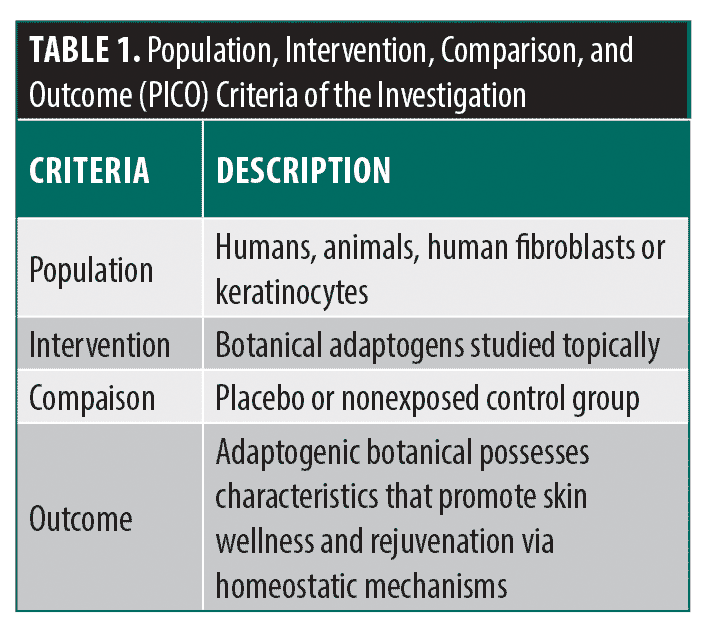
Screening and study selection. The initial search yielded a total of 643 articles. Of those, 306 duplicates were removed leaving a total of 337 articles to be screened. From these studies, 287 were from OVID, 21 were from Cochrane, and 335 were from PubMed. Rayyan systematic review collaboration software (Rayyan Systems) was used to independently screen the abstracts and titles of the 337 articles. Two researchers independently read the abstracts of 337 articles to verify the inclusion criteria were met. If there was disagreement between the 2 researchers on whether an article should be included, a third reviewer determined whether it should be included or excluded. This process yielded 178 articles for retrieval and 159 articles to be excluded. After retrieval of the full text of the 178 papers, the 2 researchers read the full texts to determine if the studies met all criteria. As a result, 12 studies were chosen to be included in the final study. The Preferred Reporting Items for Systematic Reviews and Meta-Analysis (PRISMA) method in Figure 1 details the screening and selection process.
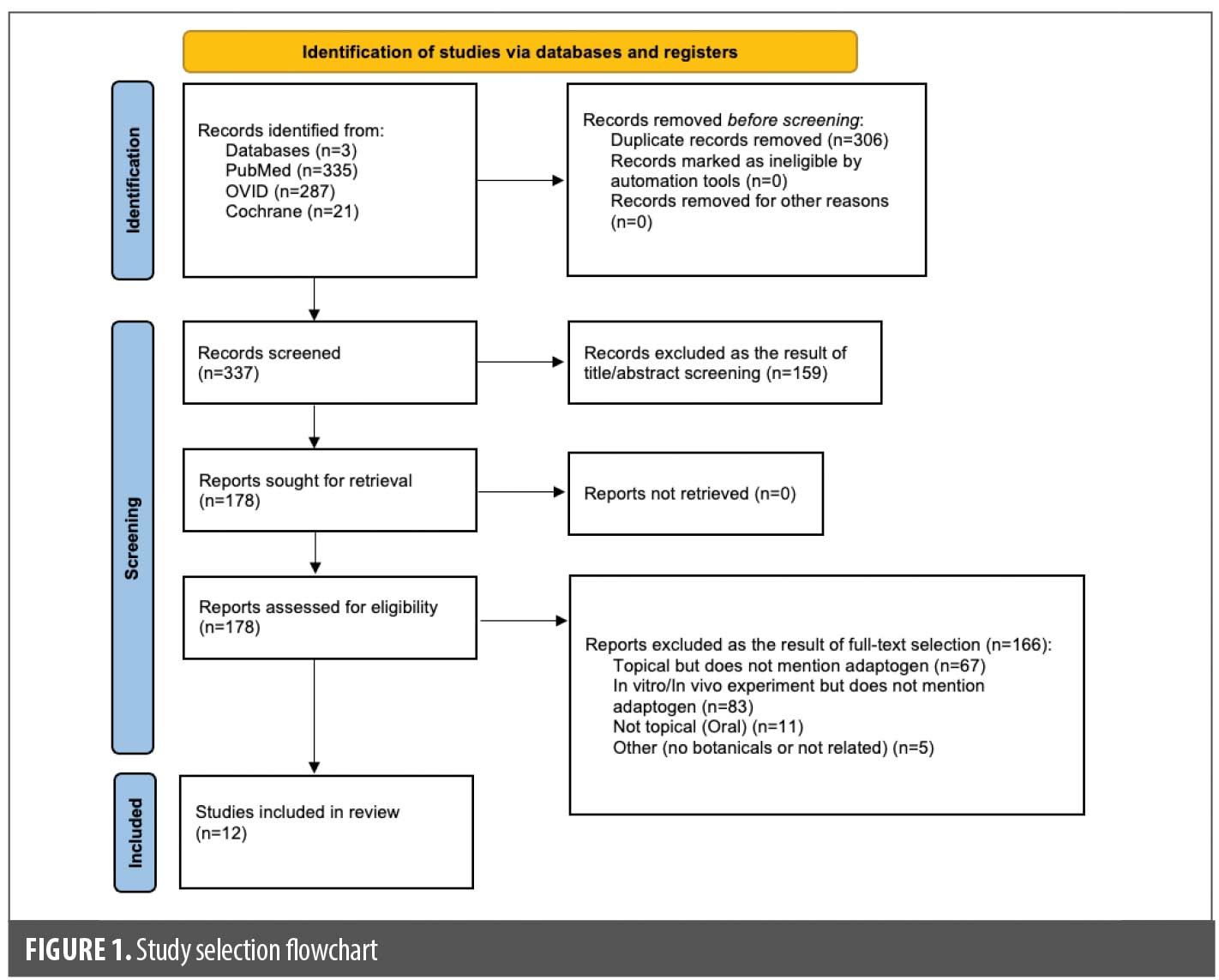
Assessment of the risk of bias. The risk of bias was assessed using the Joanna Briggs Institute Appraisal Tools (JBI) in the included studies. Two independent reviewers evaluated the risk of bias of all included articles with the JBI tool. Discrepancies between the 2 reviewers were identified and resolved through discussion with a third author. The researchers answered the questions on the checklist with “yes,” “no,” or “unclear” and then determined whether to include or exclude each study. After review, the independent reviewers met to compare their results. The articles were classified as high, moderate, or low risk of bias: score less than 50%, 50% to 70%, and score above 70%, respectively. All articles had a low risk of bias and were approved for inclusion in the study.
Data collection process. A data extraction charting form was created using Microsoft Word (Microsoft Corporation) to extract relevant information from the 12 included articles. Two reviewers independently charted the data and discussed the results. If there was discordance between the 2 researchers, a third reviewer was involved. The following sections were included in the extraction form: topical adaptogen study, adaptogens identified in the study, main study results, and mechanism of action of topical adaptogens.
Data synthesis. Once the data was extracted from the studies, a list of topical adaptogens was created based on the botanicals investigated in the studies. Additionally, their MOA or unique characteristics were documented in order to determine what makes these botanicals an adaptogen. Based on these reported MOAs, a classification system was formulated in order to assist in identifying botanicals studied topically in the skin as adaptogens.
Results
Baseline characteristics of the included studies. The systematic search resulted in 643 articles and at the end of the selection process, 12 studies remained. The baseline characteristics of the 12 studies included in this review are detailed in Table 2. The studies included in the review investigated botanicals topically and identified these botanicals as adaptogens. Five studies explored the botanicals on human skin, 6 analyzed the botanicals in vivo or in vitro on fibroblasts or keratinocytes, and 1 was clinical in humans and in vitro. The adaptogens in Table 2 were further classified as adaptogens based on meeting more than 1 criteria in our MOA model, which is further described in Figure 2. These studies revealed that adaptogenic botanicals possess characteristics that promote skin resilience, wellness, and rejuvenation via homeostatic mechanisms.
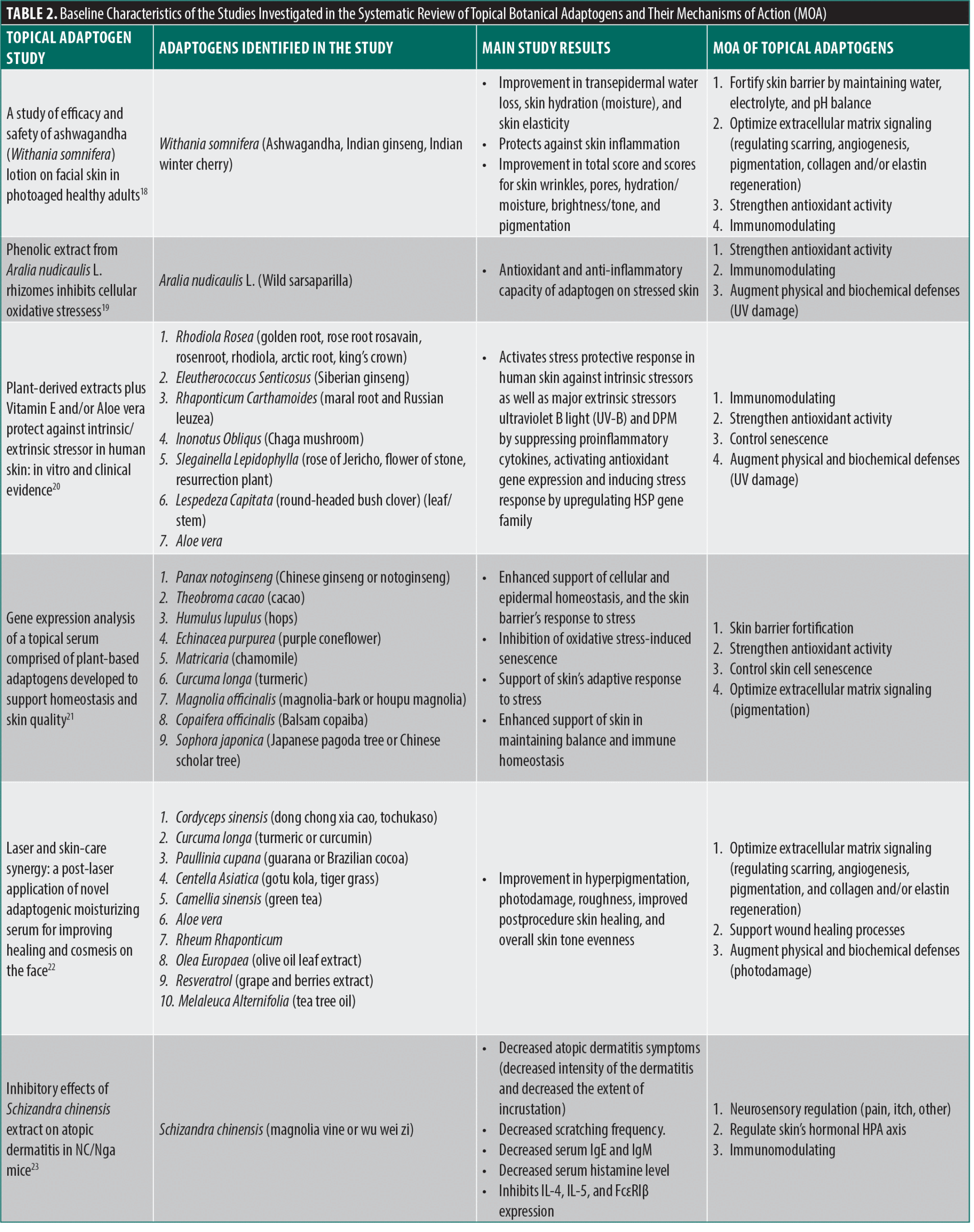
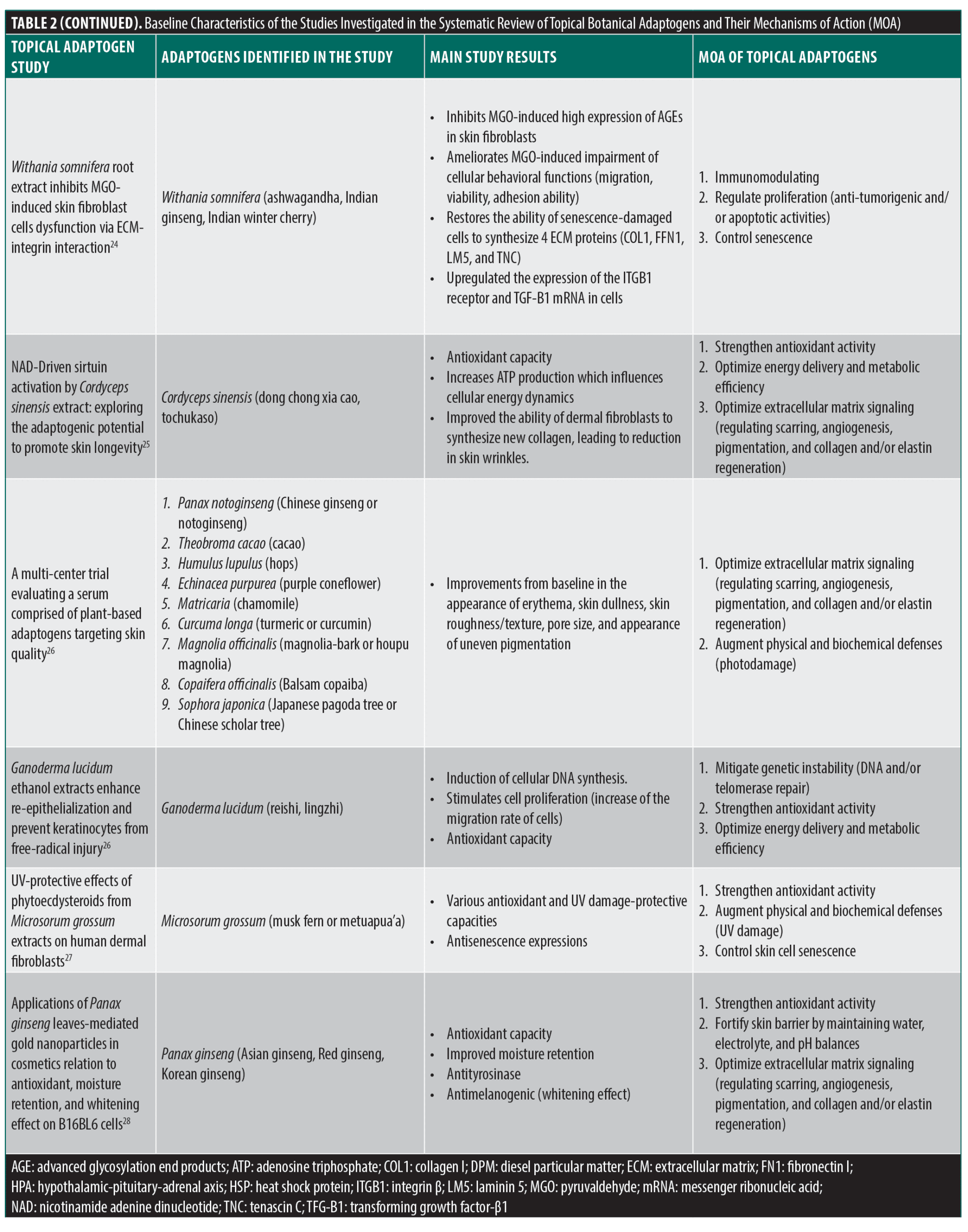
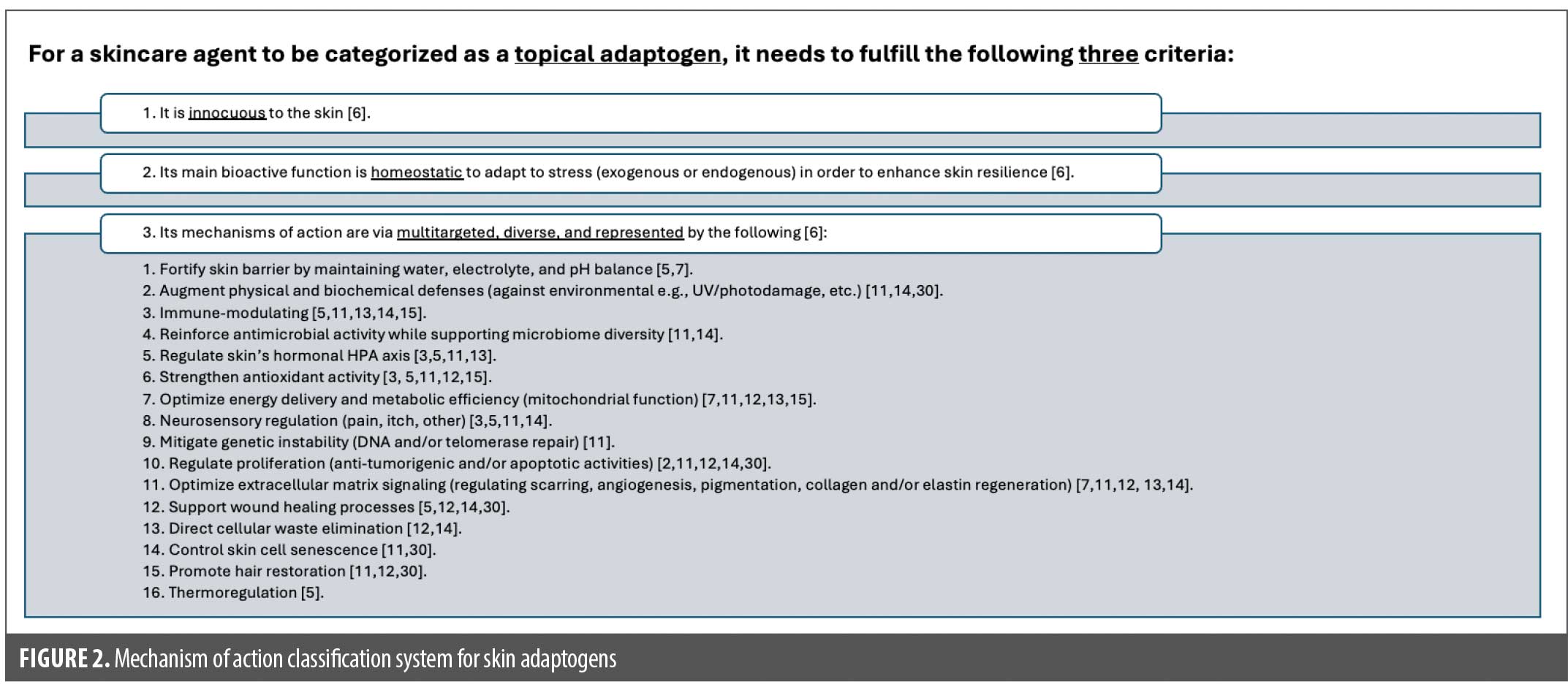
From the 12 studies included in the review, there was a total of 29 topical adaptogens studied (Table 3). Topical adaptogens are natural compounds in plants that can amplify the skin’s adaptation to stress responses mainly through equilibrating MOA. As a result, these adaptogens may exert their effects through topically applied formulations such as serums, creams, ointments, and lotions. Below, we present topical adaptogens that have been identified in scientific literature and identify an MOA based on the proposed MOA classification system.
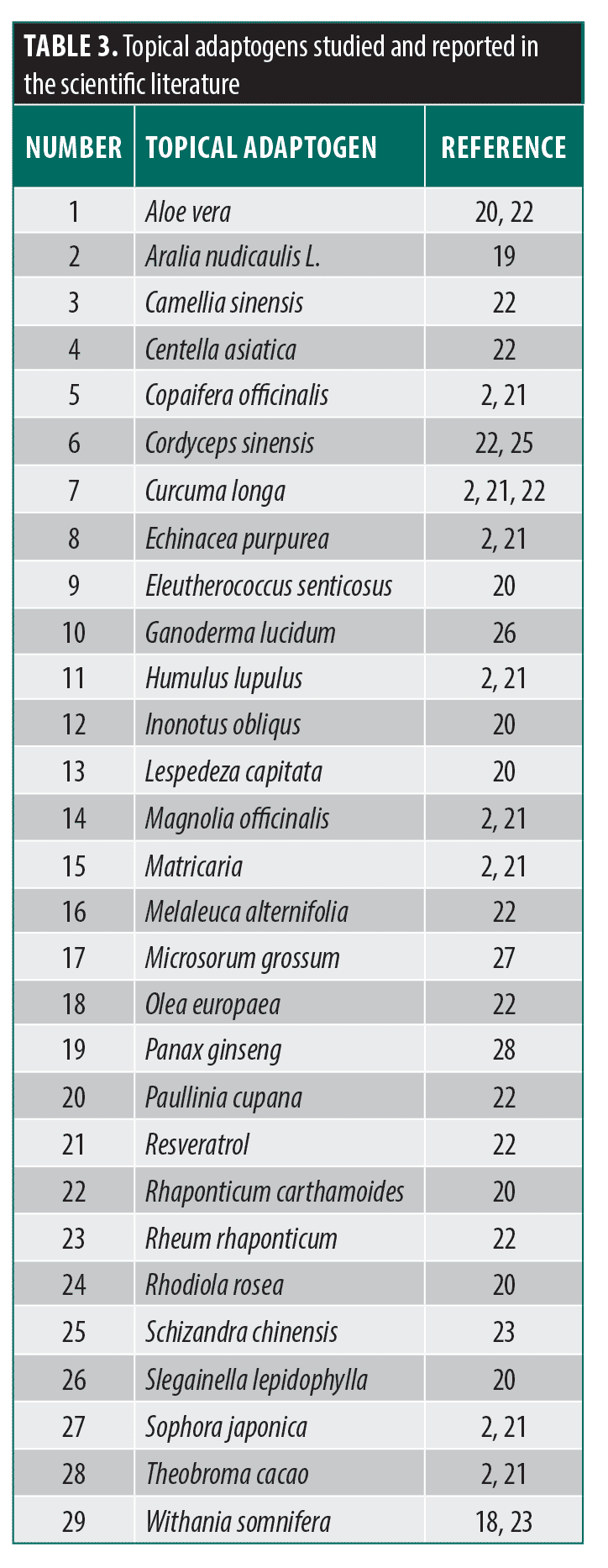
Topical adaptogen classification system. Skin adaptogens are skincare ingredients that help our skin resist and adapt to internal and external stressors. After reviewing scientific literature, we propose the following MOA model and criteria that skincare ingredients must meet in order to be considered an active topical adaptogen. To be classified as a skin adaptogen, the active ingredient must be nontoxic cutaneously and demonstrate an ability to decrease skin reactivity while enhancing skin stamina through multitargeted and homeostatic modes of action described in Figure 2.
Discussion
Our systematic review summarizes the results of 12 studies published within the last 20 years. Twenty-nine botanicals were reported as topical adaptogens, and studies have demonstrated that adaptogenic botanicals are safe and possess characteristics that promote skin resilience, wellness, and rejuvenation via diverse homeostatic mechanisms (Figure 2):
- Fortifying the skin barrier by maintaining water, electrolyte, and pH balances
- Augmenting physical and biochemical defenses
- Optimizing extracellular matrix signaling
- Immunomodulating
- Strengthening antioxidant activity
- Controlling skin senescence
- Supporting wound healing process
- Neurosensory regulation
- Regulating the skin’s hormonal hypothalamus-pituitary-adrenal (HPA) axis
- Regulating skin proliferation
- Optimizing energy delivery and metabolic efficiency
- Mitigating genetic instability
- Promoting hair restoration
- Reinforcing antimicrobial activity, while supporting microbiome diversity
- Thermoregulation
- Direct cellular waste elimination
It is through these diverse MOAs that the topical adaptogens were able to exert their normalizing effects of enhancing skin health and offer cosmetic benefits.
Several review papers have been published discussing the beneficial effects of botanicals on skin health. However, many of these botanicals have not been studied topically on the skin. Liu et al5 identified 109 adaptogens with cutaneous benefits from systemic and topical routes of delivery, and many of these botanicals have been studied or discussed in other publications.2, 3, 6, 7,12–15, 29 To the best of our knowledge, a MOA classification system for skin adaptogens has not been published. We formulated this MOA classification system (Figure 2) based on publications in the literature on the mechanisms of these adaptogenic botanicals to help medical practitioners and cosmeceutical consumers better define topical adaptogens used in skincare.
One limitation of this systematic review is the limited number of publications on topical adaptogens. Currently, we identified 12 studies that included 29 topical adaptogens. Another limitation is that some of these studies included a combination of adaptogens. It is challenging to determine which of these adaptogens fulfilled the topical adaptogen MOA criteria (Figure 2). It would be helpful in future research to isolate adaptogenic compounds and test them individually on the skin to determine which specific homeostatic functions they provide.
There are many botanical adaptogens identified that have been explored in various fields of medicine,5 although most of these have not been studied cutaneously. Likewise, there are numerous botanicals that have been studied cutaneously but have not been designated as adaptogens in the literature. If we evaluate these botanicals closer, many of them do fulfill the criteria of topical adaptogens based on our MOA classification system (Figure 2). We propose that the following botanicals can be considered topical adaptogens based on fulfilling the criteria of our MOA classification system (Figure 2):
- Andrographis paniculata30
- Astragalus membranaceus31
- Azadirachta indica (neem)32
- Cannabis sativa33
- Glycyrrhiza glabra (licorice)34
- Hibiscus sabdariffa35
- Ocimum sanctum (tulsi)36
- Psoralea corylifolia (bakuchiol)37
- Rosa canina (rosehip)38
- Santalum album39
- Silymarin40
- Tanacetum parthenium (Feverfew)41
- Tephrosia purpurea3
- Argon oil42
- Chamomile oil42
- Jojoba oil42
- Coconut oil42
- Safflower oil42
- Tamanu oil42,43
More research is needed to identify other possible cutaneous adaptogens. Although the current literature designates adaptogens as being derived mostly from botanical origin, synthetic compounds may also be studied and identified as adaptogens. This is based on the original definition of adaptogens8 being both naturally derived or synthetic agents. Future evaluation and the inclusion of potential ingredients like niacinamide,44 vitamin E,20 hypochlorous acid,45 and retinol46 as topical adaptogens could significantly enhance their value in skin therapeutics and aesthetics.
Conclusion
Under the stress of various internal and external aggressors, the skin becomes vulnerable to homeostatic disturbances and succumbs to a disease state or premature aging. In order to preserve the skin’s health, there is a demand for new active cosmeceutical ingredients that can promote resilient skin. Adaptogens are a novel category of cosmeceutical active ingredients. Based on the existing literature, 29 topical adaptogens have displayed enhancement of skin resilience by improving the skin’s adaptation to stressful stimuli. The topical adaptogens use varied MOAs, such as fortifying the skin barrier, optimizing extracellular matrix signaling, strengthening antioxidant activity, immunomodulating, augmenting physical and biochemical defenses, controlling skin senescence and wound healing process, neurosensory and HPA axis regulation, modulating proliferation, optimizing energy delivery and metabolic efficiency, and others. We propose a classification system of topical adaptogens based on these mechanisms. Further research needs to be conducted to identify other topical adaptogens as well as any other mechanisms that adaptogens may possess to enhance skin resilience.
References
- Passeron T, Zouboulis CC, Tan J, et al. Adult skin acute stress responses to short-term environmental and internal aggression from exposome factors. J Eur Acad Dermatol Venereol. 2021;35(10):1963-1975.
- Draelos ZD, Grimes PE, Watchmaker J, Nelson DB. A multi-center trial evaluating a serum comprised of plant-based adaptogens targeting skin quality. J Clin Aesthet Dermatol. 2024;17(2):15-19.
- De Tollenaere M, Meunier M, Scandolera A, et al. Well-aging: a new strategy for skin homeostasis under multi-stressed conditions. J Cosmet Dermatol. 2020;19(2):444-455.
- Michalak M. Plant-derived antioxidants: significance in skin health and the ageing process. Int J Mol Sci. 2022;23(2):585.
- Liu XX, Chen CY, Li L, et al. Bibliometric study of adaptogens in dermatology: pharmacophylogeny, phytochemistry, and pharmacological mechanisms. Drug Des Devel Ther. 2023;17:341-361.
- Panossian AG, Efferth T, Shikov AN, et al. Evolution of the adaptogenic concept from traditional use to medical systems: pharmacology of stress- and aging-related diseases. Med Res Rev. 2021;41(1):630-703.
- Todorova V, Ivanov K, Delattre C, et al. Plant adaptogens-history and future perspectives. Nutrients. 2021;13(8):2861.
- Lazarev NV. General and specific effects of drugs. Article in Russian. Farmakol Toksikol. 1958;21(3):81-86.
- Brekhman II, Dardymov IV. New substances of plant origin which increase nonspecific resistance. Annu Rev Pharmacol. 1969;9:419-430.
- Winslow LC, Kroll DJ. Herbs as medicines. Arch Intern Med. 1998;158(20):2192-2199.
- Panossian A. Understanding adaptogenic activity: specificity of the pharmacological action of adaptogens and other phytochemicals. Ann NY Acad Sci. 2017;1401(1):49-64.
- Dhanjal DS, Bhardwaj S, Sharma R, et al. Plant fortification of the diet for anti-ageing effects: a review. Nutrients. 2020;12(10):3008.
- Sharma R, Sharma P, Bhardwaj R. Adaptogens: new age healing gems for physical wellbeing. Am J Multidiscip Res Dev. 2021;3(10):26-35.
- Maurya SK, Divakar S, Patil UK. Potentials of plant derived products for the treatment of skin disorders. Ger J Pharm Biomater. 2023;2(3):9-31.
- Cavagnino A, Breton L, Ruaux C, et al. Adaptogen technology for skin resilience benefits. Cosmetics. 2023;10(6):155.
- Datta HS, Paramesh R. Trends in aging and skin care: Ayurvedic concepts. J Ayurveda Integr Med. 2010;1(2):110-113.
- Kotnala A, Verma K, Sharma A, et al. Indian medicinal plants for skin care and cosmeceuticals: a review. J Biomed Ther Sci. 2019;6(2):24-60.
- Narra K, Naik SK, Ghatge AS. A study of efficacy and safety of ashwagandha (Withania somnifera) lotion on facial skin in photoaged healthy adults. Cureus. 2023;15(3):e36168.
- Lion Q, Pichette A, Mihoub M, Mshvildadze V, Legault J. Phenolic extract from Aralia nudicaulis L. rhizomes inhibits cellular oxidative stresses. Molecules. 2021;26(15):4458.
- Diwakar G, Barnes L, Riggs M, Knaggs H, Draelos ZD. Plant-derived extracts plus Vitamin E and/or Aloe vera protect against intrinsic/extrinsic stressor in human skin: in vitro and clinical evidence. Front Biosci (Landmark Ed). 2023;28(12):366.
- Draelos ZD, Grimes PE, Watchmaker J, Nelson DB. Gene expression analysis of a topical serum comprised of plant-based adaptogens developed to support homeostasis and skin quality. J Clin Aesthet Dermatol. 2024;17(2):43-46.
- Blyumin-Karasik M, Colon J, Nguyen S, Rosen J. Laser and skin-care synergy: a post-laser application of novel adaptogenic moisturizing serum for improving healing and cosmesis on the face. J Cosmet Dermatol. 2025;24(2):e16668.
- Kang YH, Shin HM. Inhibitory effects of Schizandra chinensis extract on atopic dermatitis in NC/Nga mice. Immunopharmacol Immunotoxicol. 2012;34(2):292-298.
- Liu X, Chen C, Lin Y, et al. Withania somnifera root extract inhibits MGO-induced skin fibroblast cells dysfunction via ECM-integrin interaction. J Ethnopharmacol. 2024;323:117699.
- Di Lorenzo R, Falanga D, Ricci L, et al. NAD-driven sirtuin activation by Cordyceps sinensis extract: exploring the adaptogenic potential to promote skin longevity. Int J Mol Sci. 2024;25(8):4282.
- Abate M, Pepe G, Randino R, et al. Ganoderma lucidum ethanol extracts enhance re-epithelialization and prevent keratinocytes from free-radical injury. Pharmaceuticals (Basel). 2020;13(9):224.
- Ho R, Teai T, Meybeck A, Raharivelomanana P. UV-protective effects of phytoecdysteroids from Microsorum grossum extracts on human dermal fibroblasts. Nat Prod Commun. 2015;10(1):33-36.
- Jiménez-Pérez ZE, Singh P, Kim YJ, et al. Applications of Panax ginseng leaves-mediated gold nanoparticles in cosmetics relation to antioxidant, moisture retention, and whitening effect on B16BL6 cells. J Ginseng Res. 2018;42(3):327-333.
- Csekes E, Račková L. Skin aging, cellular senescence and natural polyphenols. Int J Mol Sci. 2021;22(23):12641.
- You J, Roh KB, Li Z, et al. The antiaging properties of Andrographis paniculata by activation epidermal cell stemness. Molecules. 2015;20(9):17557-17569.
- Li Q, Wang D, Bai D, et al. Photoprotective effect of Astragalus membranaceus polysaccharide on UVA-induced damage in HaCaT cells. PLoS One. 2020;15(7):e0235515.
- Gopinath H, Karthikeyan K. Neem in dermatology: shedding light on the traditional panacea. Indian J Dermatol. 2021;66(6):706.
- Baswan SM, Klosner AE, Glynn K, et al. Therapeutic potential of cannabidiol (cbd) for skin health and disorders. Clin Cosmet Investig Dermatol. 2020;13:927-942.
- Asl MN, Hosseinzadeh H. Review of pharmacological effects of Glycyrrhiza sp. and its bioactive compounds. Phytother Res. 2008;22(6):709-724.
- Wang D, Nagata M, Matsumoto M, Amen Y, Wang D, Shimizu K. Potential of Hibiscus sabdariffa L. and hibiscus acid to reverse skin aging. Molecules. 2022;27(18):6076.
- Pattanayak P, Behera P, Das D, Panda SK. Ocimum sanctum Linn. A reservoir plant for therapeutic applications: an overview. Pharmacogn Rev. 2010;4(7):95-105.
- Puyana C, Chandan N, Tsoukas M. Applications of bakuchiol in dermatology: systematic review of the literature. J Cosmet Dermatol. 2022;21(12):6636-6643.
- Phetcharat L, Wongsuphasawat K, Winther K. The effectiveness of a standardized rose hip powder, containing seeds and shells of Rosa canina, on cell longevity, skin wrinkles, moisture, and elasticity. Clin Interv Aging. 2015;10:1849-1856.
- François-Newton V, Brown A, Andres P, et al. Antioxidant and anti-aging potential of Indian sandalwood oil against environmental stressors in vitro and ex vivo. Cosmetics. 2021; 8(2):53.
- Draelos ZD, Kerscher M, Lynch S, White S, Choudhary H. A silymarin antioxidant serum improves facial acne alone and as part of a treatment regimen. J Drugs Dermatol. 2024;23(4):233-238.
- Michalak M, Stryjecka M, Żarnowiec P, Zagórska-Dziok M, Kiełtyka-Dadasiewicz A. Chemical composition of extracts from various parts of feverfew (Tanacetum parthenium L.) and their antioxidant, protective, and antimicrobial activities. Int J Mol Sci. 2024;25(22):12179.
- Lin TK, Zhong L, Santiago JL. Anti-inflammatory and skin barrier repair effects of topical application of some plant oils. Int J Mol Sci. 2017;19(1):70.
- Ansel JL, Lupo E, Mijouin L, et al. Biological activity of Polynesian Calophyllum inophyllum oil extract on human skin cells. Planta Med. 2016;82(11-12):961-966.
- Oblong JE, DeAngelis YM, Jarrold BB, et al. Optimized low pH formulation of niacinamide enhances induction of autophagy marker ATG5 gene expression and protein levels in human epidermal keratinocytes. J Eur Acad Dermatol Venereol. 2020;34(suppl 3):3-11.
- Del Rosso JQ, Bhatia N. Status report on topical hypochlorous acid: clinical relevance of specific formulations, potential modes of action, and study outcomes. J Clin Aesthet Dermatol. 2018;11(11):36-39.
- Quan T. Human skin aging and the anti-aging properties of retinol. Biomolecules. 2023;13(11):1614.
